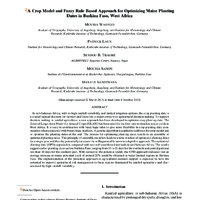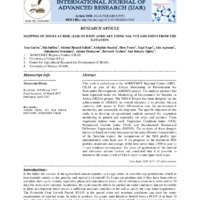Recherche
7 items
Operational guide on AGRHYMET RCC-WAS services
This operational guide is dedicated to public, academic and private institutions working in the fields of climate, water, environment, agriculture, livestock, plant protection, food and nutrition security, climate disaster risk reduction, and any other related sectors using (or wishing to use) the products and services of AGRHYMET Regional Climate Centre for West Africa and the Sahel (AGRHYMET RCC-WAS), which is a specialized
agency of the Permanent Inter-State Committee for Drought Control in the Sahel (CILSS). Its main objective is to enhance the value of AGRHYMET RCC-WAS's various products and services, by making them more visible and attractive to development stakeholders (public, academic and private), decision-makers and partners
(technical and financial), through their performance, relevance, and effectiveness in meeting the specific and collective needs of different users in the countries of West Africa, the Sahel, and other zones. The guide maps out the various services provided by AGRHYMET RCC-WAS, which is a benchmark institution in the sub-region for diploma and continuing training in the various fields listed above, and for building the operational capacities of state, university and private technical institutions involved in reducing hydro-climatic and phytosanitary risks and improving the productivity of agro-sylvo-pastoral and environmental systems in West Africa and the Sahel. It explains the different types of services that AGRHYMET RCC-WAS provides or can provide, as well as the modalities and procedures that state technical institutions and other applicants must adopt to gain access to them, in accordance with their specific or collective, immediate, or future needs, and in compliance with environmental and social safeguard standards.
A Crop Model and Fuzzy Rule Based Approach for Optimizing Maize Planting Dates in Burkina Faso, West Africa
In sub-Saharan Africa, with its high rainfall variability and limited irrigation options, the crop planting date is a crucial tactical decision for farmers and therefore a major concern in agricultural decision making.
consolidated teaching guide on the prevention and management of conflicts in connection with mobile farming
The Integrated Farming Project and Pastoralism and Secure in West Africa (PEPISAO) undertook the design of a teaching guide, for the prevention and management of conflicts related to mobile livestock. This document will provide orderly and practical content for stakeholders in particular, technicians accompanying projects as well as direct stakeholders in the field (POs, transhumance committees, etc.). It should be remembered that the objective of PEPISAO is "to reduce conflicts linked to pastoralism by initiating the construction of a shared regional vision on the different ruminant
farming methods ".
Guide to integrating nutrition into nutrition-sensitive sectoral strategic documents in the Sahel West Africa
The stakeholders involved in the project to Improve Food and Nutrition Governance and Sustainable Agriculture in the Sahel and West Africa (PAGR-SANAD), notably ECOWAS, UEMOA, CILSS and CEI/PREGEC region through ROPPA, have been heavily involved in improving the food and nutrition situation for many years. On an institutional level, nutrition has been considered, following the accession of all the countries in the Sahel and West Africa region to the Scaling Up Nutrition (SUN) movement. Almost all the countries have revised their nutrition policies and strategies in line with the multi-sectoral approach. However, the issues of nutrition-sensitive sustainable food security remain a major challenge.
Mapping of Zones At Risk (ZAR) in west Africa by using NGI, VCI and SNDVI from the E-statuib
This work is carried out at the AGRHYMET Regional Centre (ARC)-CILSS as part of the African Monitoring of Environment for Sustainable Development (AMESD) project. The analysis protocol has been improved under the Monitoring of Environment for Security in Africa (MESA) project. The MESA Project has been designed on the achievements of AMESD; its overall objective is to provide African countries with access to Earth Observation data for environmental monitoring and sustainable development. The specific objective of this study is to develop an operational analysis protocol for vegetation monitoring in general and especially for crops and pastures. Three vegetation indices were used: Vegetation Condition Index (VCI), Normalized Growth Index (NGI) and Standardized Normalized Difference Vegetation Index (SNDVI). The analysis of these drought indices is based on taking into account the agro-climatic characteristics of the Sahelian region, the comparison of the NGI profile (per administrative unit) from year X (in progress) to the maximum NGI profiles, minimum and average of the time series data (1998 to year x-1) and evidence convergence. Six years of application of the method and validation actions carried out concluded that it is possible to determine the zones at risk (ZAR) in order to anticipate food crises.
Performance of similarity analysis in the estimation of forage yields in the Sahelian zone of Niger
The study aims to test the performance of similarity analysis in herbaceous fodder biomass estimate in the Nigerian pastoral zone, in a context of insecurity and precipitation spatiotemporal variability. It is carried out on the time series of NDVI decadal images of SPOT VEGETATION for the period from 2001 to 2012 and on fodder biomasses measured in situ during the same period. Similarity analysis compares NDVI seasonal patterns to detect similar years using three criteria: the RMSE (Root Mean squared error), the MAD (Mean absolute Deviation), and R². Exploratory statistical analyzes with bootstrap are carried out to better characterize the observations resulting from the simulation. Moreover, the analysis of the parametric and non-parametric correlations is carried out to evaluate the level of link between the simulated data and the real data. The t test and the Wilcoxon test are then carried out in order to compare the means of the actual biomasses with those obtained by the similarity analysis. At the local level, the results indicate that the R² is more efficient than the RMSE and the MAD which have almost the same performances. The results of the similarity calculated with R² can be used as a proxy to the herbaceous phytomass measured in situ, as there is no significant difference between the simulated mean and the mean measured at the 1% threshold. On the other hand, the results of the similarity calculated with the RMSE and the MAD are not exploitable. Parametric and nonparametric correlations are all significant at the 1% threshold. However, the R² are low and vary between 0.32 and 0.45. It therefore seems necessary to continue the research, as numerous studies have revealed very good links between certain indices like the FAPAR, the EVI and the LAI and the aerial phytomasse.
VALIDATION OF A HERBACEOUS BIOMASS ASSESSMENT MODEL FOR SAHELIAN RANGELANDS (BIOMASAH) IN NIGER
This study was carried out in the pastoral zone of Niger with the aim of validating outputs of the BIOMASAH model developed by the AGRHYMET Regional Centre (ARC) relative to real data collected over the 2001-2011 period by the Ministry Livestock and Animal Industries (MEIA) of Niger. We used parametric tests (t-tests) and nonparametric tests (Wilcoxon and sign tests) for mean comparisons. A correlation analysis was performed by calculating Pearson’s r, Spearman’s ρ, Kendall’s T and Hoeffding’s D correlation coefficients. The results showed that the BIOMASAH model generally overestimated biomass (983.17 vs. 591.17 kg/ha) with a highly significant difference relative to the field findings (P <.0001). Pearson’s r (0.15), Spearman’sρ (0.22) Kendall’s T (0.13) and Hoeffding’s D (0.1) correlation coefficients were low but highly significant (p <.0001). Grazing pressure and spatiotemporal variability of rainfall helped explain the noted differences.




